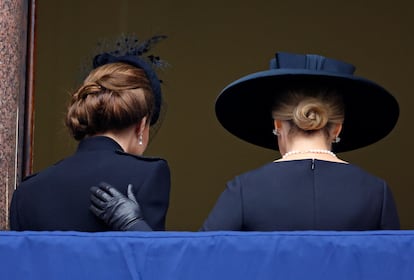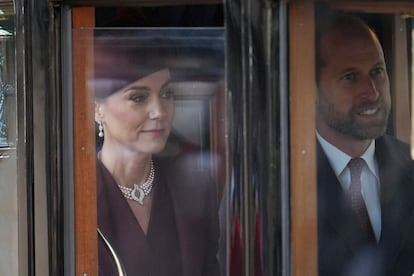When Catherine, Princess of Wales, appeared during the Remembrance Sunday celebrations on November 10 in front of the Cenotaph, the monument to the victims of war in London’s Whitehall Avenue, the media described her as a “queen in-waiting.”
The rhythm she has adopted for her return to public life after intense chemotherapy treatment, has been a statement of intent: the wife of the heir to the British throne wants to be master of her own time and agenda. Her willingness to resume official duties will always come second to her health, and the 42-year-old Princess has illustrated this with the careful choosing of her moments in the public eye.
Remembrance Day is the closest thing to a national holiday in the United Kingdom. It is an occasion when the royal household, the government and the opposition, come together in an act of great solemnity. The absence of Queen Camilla, due to a lung infection, meant Kate Middleton was the absolute center of attention. “Not only was there her return to royal life following her recent illness, but Camilla’s ill health placed her firmly in the spotlight as the senior royal on the Whitehall balcony, standing where the late Queen would have once stood, flanked by Camilla, Sophie and Kate, or previously Diana,” Judi James, a self-styled body language expert, told The Sun tabloid.
Accompanying the Princess on the balcony was Prince Edward’s wife, Sophie, the Duchess of Edinburgh. And at the end of the event, Sophie’s hand on Kate’s back did not go unnoticed. This is part of a protective strategy being adopted by the royals as Kate returns to the stage, though her treatment is not yet finished, and she still has her good and bad days. The night before, she and William had attended the Royal British Legion Festival of Remembrance, held at the Royal Albert Hall in London. At the entrance, the Prince of Wales also put a protective hand on his wife’s back.

The situation has bolstered William’s popularity and the respect he gets in the press. “It’s been a hell of a year. He has had to help his wife cope with a very serious illness and, at the same time, he has had to stand in for his father, who is also suffering from cancer, at official events,” explains Robert Hardman, King Charles’ biographer and the most prestigious royal observer in the U.K.

Kate has made it to two public events, a few hours apart, and a third, just three weeks later. At the start of December, she welcomed the Emir of Qatar and his wife, Sheikha Jawaher, to Kensington Palace. She wore a burgundy coat by Sarah Burton for Alexander McQueen, for the occasion, twinned with a Chanel bag and Gianvito Rossi boots, and discreet pearls. The burgundy is a nod to the guests — in this case, to the colors of the flag of Qatar. Kate appeared tired in a way she had not on previous occasions. But the act was significant as it was her first full compliance with protocol since her return to the spotlight.
It is tradition for the heir to the throne and his wife to be the first to welcome foreign dignitaries visiting the U.K., and accompany them to the parade at the Royal Stables before they meet the monarch. Kate Middleton did not participate in the reception of the emperors of Japan last June, but she did want to be present at that of the Emir of Qatar. “She has managed the expectations of the public very well,” Sally Bedell Smith, part of a small group of American royal commentators, told People magazine.
Kate’s most recent public appearance was at the carol service at Westminster Abbey. Together at Christmas is Kate’s baby; she sent a letter beforehand to the 1,600-odd guests at the concert, which she attended with William and her three children.
“Christmas is one of my favorite times of the year. It is a time for celebration and joy, but it also gives us the opportunity to slow down and reflect on the deeper things that connect us all,” she wrote in a message that she described on the official Instagram of the Prince and Princess of Wales, as “a special letter, reflecting on the importance of love, empathy and how much we need one another in the most difficult times.”
Sign up for our weekly newsletter to get more English-language news coverage from EL PAÍS USA Edition




